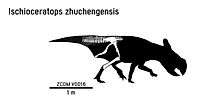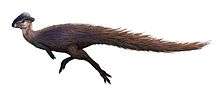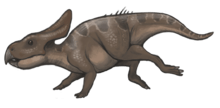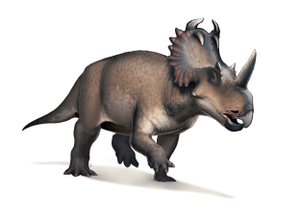Ischioceratops
Ischioceratops is an extinct genus of small ceratopsian dinosaur that lived approximately 69 million years ago during the latter part of the Cretaceous Period in what is now China. Ischioceratops was a small sized, moderately-built, ground-dwelling, quadrupedal herbivore, whose total body length has been estimated to be about 2 meters. The ceratopsians were a group of dinosaurs with parrot-like beaks which fed on vegetation and thrived in North America and Asia during the Cretaceous Period, which ended approximately 66 million years ago, at which point they all became extinct. Its name means "ischium horned face", referring to the peculiar shape of the ischiatic bones.[1]
| Ischioceratops | |
|---|---|
| Holotype | |
| Scientific classification | |
| Kingdom: | Animalia |
| Phylum: | Chordata |
| Clade: | Dinosauria |
| Order: | †Ornithischia |
| Family: | †Leptoceratopsidae |
| Genus: | †Ischioceratops |
| Species: | †I. zhuchengensis |
| Binomial name | |
| †Ischioceratops zhuchengensis He et al., 2015 | |
Ischioceratops existed in the Wangshi Group during the late Cretaceous. It lived alongside centrosaurines, saurolophines, and tyrannosaurines. The most common creatures in the formation were Sinoceratops and Zhuchengtyrannus.
Description

Ischioceratops is one of the few ceratopsian dinosaurs which is not known by the skull. The most peculiar traits were located in the ischium, which shows a unique morphology. Another characteristic of Ischioceratops was the presence of a caudal elevation in its proximal part, which is present also in Protoceratops, Koreaceratops and in a more similar way in Montanoceratops and Cerasinops. The taxon has been referred to Leptoceratopsidae and distinguished from other known leptoceratopsids based on the following combination of characters: nine sacral vertebrae, more than in any other known basal (non-ceratopsid) ceratopsian but fewer than in ceratopsids; the ischium has a robust shaft that resembles that of a recurved bow and flares gradually to form a subrectangular-shaped obturator process in its middle portion. An elliptical fenestra perforates the obturator process.[1]
Discoveries and species
The holotype (ZCDM V0016) was discovered in Kugou, a locality in the Shandong Province of China which presents layers of the Upper Cretaceous Wangshi Group. It is part of the Zhucheng Dinosaur Museum collection and it includes an incomplete, partially articulated specimen comprising the entire sacrum, a few ossified tendons, both halves of the pelvis, the anteriormost 15 caudal vertebrae in an articulated series, and the right femur, tibia and fibula.[1]
Ischioceratops was one of eighteen dinosaur taxa from 2015 to be described in open access or free-to-read journals.[2]
Classification

Phylogenetic analyzes confirmed Ischioceratops as a leptoceratopsid. Its closest relative taxon has appeared to be Montanoceratops. The following cladogram is based on a 2015 analysis by Yiming He, Peter J. Makovicky, Kebai Wang, Shuqing Chen, Corwin Sullivan, Fenglu Han, Xing XuMichael J. Ryan, David C. Evans, Philip J. Currie, Caleb M. Brown and Don Brinkman.[1]
| Leptoceratopsidae |
| ||||||||||||||||||||||||||||||||||||||||||||||||||||||
| |||||||||||||||||||||||||||||||||||||||||||||||||||||||
See also
References
- Yiming He; Peter J. Makovicky; Kebai Wang; Shuqing Chen; Corwin Sullivan; Fenglu Han; Xing XuMichael J. Ryan; David C. Evans; Philip J. Currie; Caleb M. Brown; Don Brinkman (2015). "A New Leptoceratopsid (Ornithischia, Ceratopsia) with a Unique Ischium from the Upper Cretaceous of Shandong Province, China". Cite journal requires
|journal=(help) - "The Open Access Dinosaurs of 2015". PLOS Paleo.


